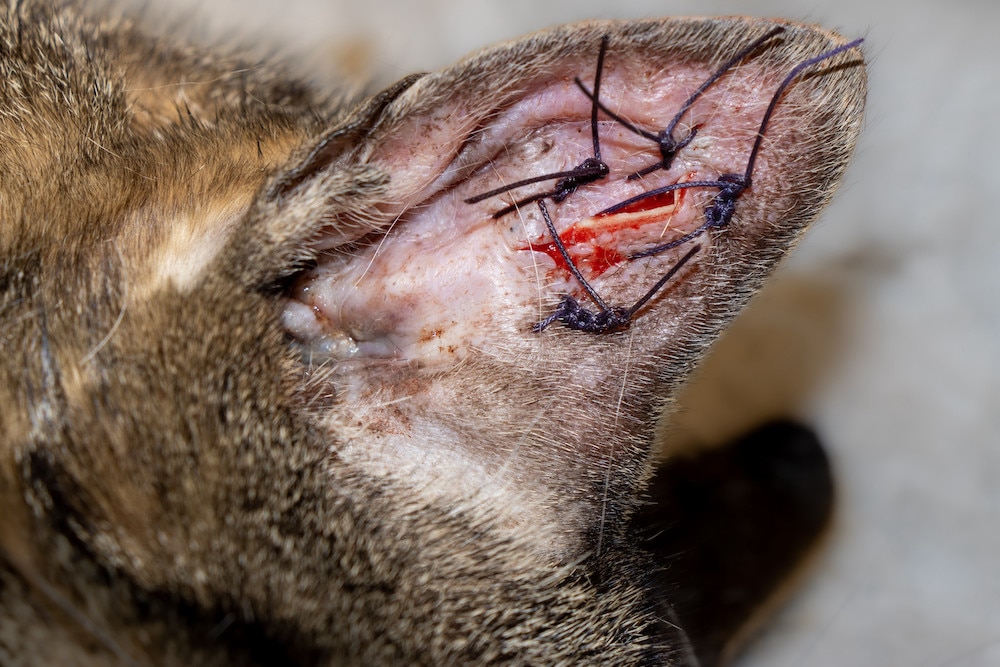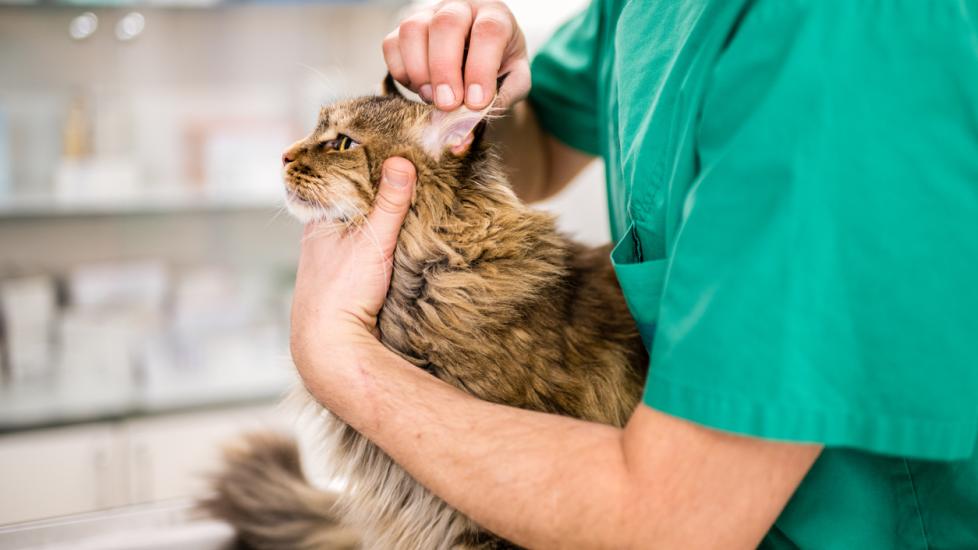Cat Ear Hematoma
What Is Cat Ear Hematoma?
An ear hematoma is an accumulation of blood caught between the ear’s cartilage and skin. Most cat ears stand upright because of a strip of cartilage in the ear, which is covered with skin. There are also many arteries, veins, and nerves in this area. The external part of the ear that we can see is called the pinna.
Head shaking and scratching can cause small areas of skin to detach from the underlying cartilage, as well as damage the cartilage itself. The traumatized blood vessels leak blood into the space between the cartilage and skin, resulting in a puffy, soft, fluid-filled area of the ear. This swollen, blood-filled area can be limited to a section of the ear or entirely consume it.
Even once the ear has healed, scar tissue and fibrosis may form, giving the ear a wrinkled appearance. People often call this a cauliflower ear.
Symptoms of Cat Ear Hematoma
Hematomas usually appear on the underside of the ear. These fluid-filled sacs can be small—just a few millimeters—or involve the entire ear. Frequently, only one ear is affected. The swelling is soft, movable, and compressible, and may be red or painful to the touch.
Cats with ear hematomas may display the following clinical signs:
-
Head shaking
-
Scratching at the ears
-
Head tilt
-
Ear pain
-
Ear discharge and odor
-
Dirty, inflamed ear canals
-
Swollen, red, and ulcerated pinna

Causes of Cat Ear Hematoma
The most common cause of ear hematomas in cats is trauma from head shaking or scratching secondary to otitis externa, or external ear inflammation, generally due to an ear infection. The fluid in ear infections is typically a mix of bacteria and yeast but may have an underlying allergic component.
Other possible reasons for the head shaking and scratching that causes hematomas include:
-
Ear mites (to which kittens and outside cats are most prone)
-
Trauma or injury from fights or bites
-
Foreign material, polyps, or cancer that cause otitis externa
-
Fragile blood vessels in some conditions, such as Cushing’s disease
An immune-mediated hematoma formation is also possible, but much less likely.
How Veterinarians Diagnose Cat Ear Hematoma
An ear hematoma is typically suspected on physical exam. A veterinarian may notice a soft, fluid-filled pouch on the ear, usually with a history of head shaking or scratching. While the diagnosis of fluid in the ear is done on exam, a sample of the fluid may be required to confirm the presence of blood.
It is important to note that while fluid testing is required for a confirmed diagnosis of ear hematoma, it is not required for treatment in all cases. In fact, in some cases, draining the blood with a needle may make the condition worse and the ear will fill with even more fluid.
A veterinarian may perform additional tests to get to the underlying cause of the hematoma:
-
Cytology of the ear canals is performed to look for yeast mites or bacteria, since most hematomas are secondary to ear infection.
-
A complete otic (ear) exam will rule out foreign material or growths in the ear canal, and visualize the ear drums for any tears.
-
Blood tests are conducted to rule out any underlying metabolic diseases.
Treatment of Cat Ear Hematoma
Many small ear hematomas resolve on their own if the underlying condition, like an ear infection, is appropriately treated. Often, treatment of the infection, anti-inflammatories, and pain medications are all that is needed to treat a cat’s ear hematoma.
It is uncommon for ear hematomas to resolve on their own without medical intervention. Most often, a small hematoma will continue to grow as it becomes more irritating to the cat, causing additional and more aggressive head shaking and scratching.
Some veterinarians may place an open drain, or cannula, in larger hematomas. This allows for any blood to immediately drain. Eventually, the cartilage and vessels repair themselves, and the drain is removed. As one can imagine, this method is messy, and pet parents should expect their pet to wear an e-collar and be confined to a room.
Another nonsurgical option is to drain the blood and inject a steroid into the space. The ear will likely refill with blood quickly, but the steroid may help long-term.
Medications for Cat Ear Hematoma
Some cats may need systemic antibiotics in addition to any topical treatments used for ear infections.
A nonsteroidal anti-inflammatory drug (NSAID) such as Meloxicam or Onsior, is sometimes needed for pain management as well as to decrease inflammation within the ear canal. These medications can have serious side effects and should only be used for short periods of time.
More serious cases of ear hematoma may require a steroid to decrease the inflammation. However, steroids have well-known side effects in cats, such as diabetes, so should be used as a last resort, and with caution.
Cold laser therapy may also help speed up the healing process.
Surgery for Cat Ear Hematoma
Surgery may be indicated in some conditions, and for chronic issues. The surgeon uses suture material to tack down the ear cartilage throughout the entire ear.
How Much Does Cat Hematoma Surgery Cost?
Ear hematoma surgery may cost less than $1,000, if performed by a general practitioner. However, a specialist may charge two or three times that amount, depending on the location.
Recovery and Management of Cat Ear Hematoma
Any infection present will likely need to be rechecked every 1 to 2 weeks until resolved. If not drained, the ear hematoma may take longer to resorb and go away. As long as the cause of head shaking and scratching is fixed, the hematoma should not get worse on its own—but may take weeks to fully heal. Recurrence is possible, depending on the underlying cause.
Surgical pet patients require recheck appointments, as well as incision management, for approximately two weeks, in addition to treating any other infections.
References
-
Tilley LP, Smith FWK. The 5-Minute Veterinary Consult: Canine and Feline. Lippincott Williams & Wilkins; 2005.
-
Morgan DVM, DACVIM, DACVO, Rhea V. Veterinary Information Network. Aural Hematoma (Feline). March 2019.
Featured Image: iStock.com/simonkr
